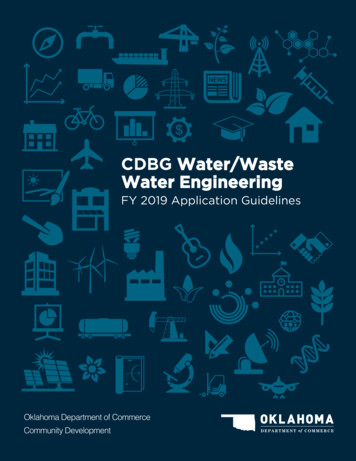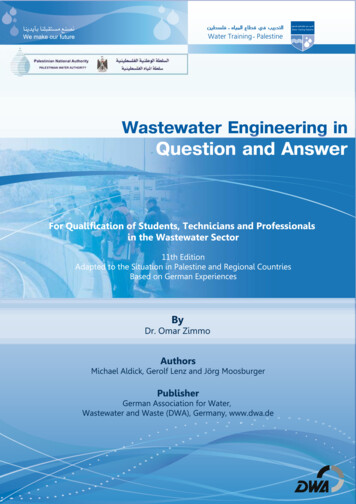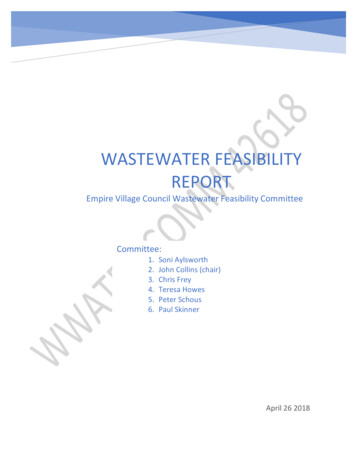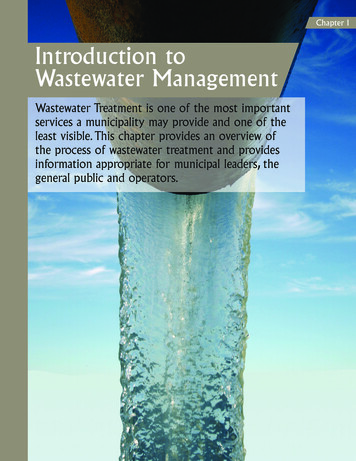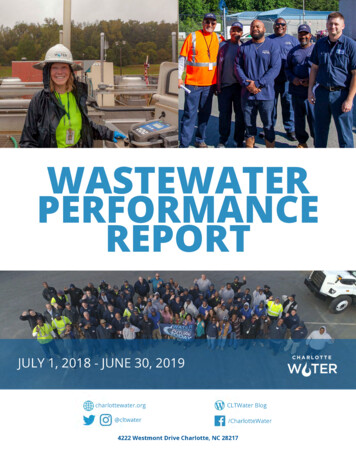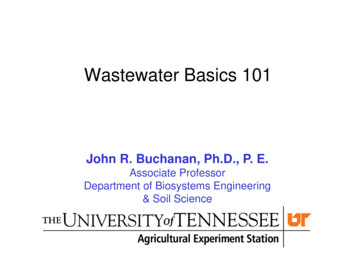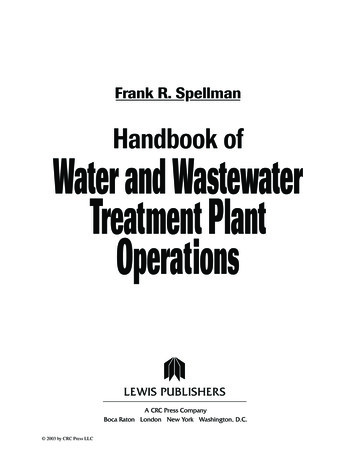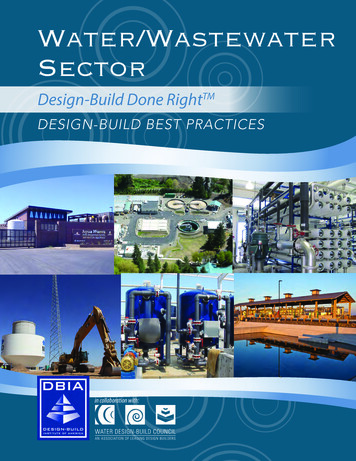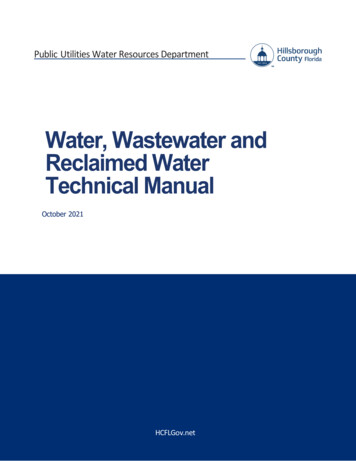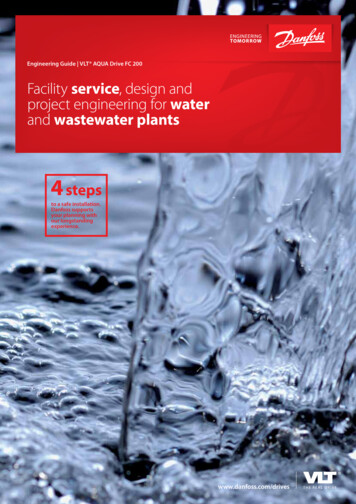
Transcription
Engineering Guide VLT AQUA Drive FC 200Facility service, design andproject engineering for waterand wastewater plants4 stepsto a safe installation.Danfoss supportsyour planning withour longstandingexperience.www.danfoss.com/drives
The removable design checklist at the back of this manualleads you to optimal design results in four steps.2
ContentsDesign aids. 6Part 1: Basics. 8Reducing costs and increasing convenience. 8Speed control saves energy. 9Boosting cost effectiveness. 10Achieving potential savings in practice. 11Part 2: Four steps to an optimal system. 12Step 1: Practical aspects of AC mains systems. 12Recognising the actual mains configurationPractical aspects of electromagnetic compatibility (EMC). 13Electromagnetic effects work in both directionsThe responsibility rests with the operatorTwo possible means of reductionDistinguishing between conducted and radiated interference. 14Coupling mechanisms between electrical circuitsConductive couplingCapacitive couplingRadiation couplingPractical aspects of mains power quality. 15Low-frequency mains interferenceSupply networks at riskQuality assured by statutory provisionsHow mains interference occursPractical aspects of low- frequency mains interference . 16Effects of mains interferenceUndervoltage warningsHigher lossesAre interference- free frequency converters available ?Analysing mains interferencePractical aspects of mains interference reduction. 17Options for reducing mains interferenceChokes at the input or in the DC linkRectifier with 12, 18 or 24 pulses per cyclePassive filtersAdvantages of passive filtersDrawbacks of passive filtersActive filters. 18Advantages of active filtersDrawbacks of active filtersCurrent and Distortion Spectrum at Full loadSlim DC link. 19Active front endAdvantages of AFE . 20Drawbacks of AFEPractical aspects of high-frequency interference (RFI). 21Radio frequency interferenceStandards and directives define limitsPractical aspects of 1st and 2nd environment . 22The operating site is the decisive factorEnvironment 1 (Class B): residential environmentEnvironment 2 (Class A): industrial environmentSpecial environmentsNo compromisesPractical aspects of mains protection measures. 23Power factor correctionMains transientsPractical aspects of operation with a transformer or standby generator. 24Maximum transformer utilisationTransformer loadPower qualityOperation with a standby generator3
ContentsStep 2: Practical aspects of ambient and environmental conditions. 25The right installation location:Cabinet mount versus wall mountPractical aspects of IP ratings. 26IP rating scheme according to IEC 60529Practical aspects of cooling design. 27Compliance with ambient temperature specificationsCoolingRelative humidityPractical aspects of special requirements. 28Aggressive atmosphere or gasesDust exposure . 29Reduced coolingCooling fansFilter matsPractical aspects of potentially explosive atmospheres. 30Potentially explosive atmospheresStep 3: Practical aspects of motors and cabling. 31Minimum efficiency classes for motorsMandatory minimum efficienciesIE and Eff classes: major differences in detailsAffected three-phase motorsPractical aspects of IE classification of motors .32Schedule for MEPS implementationCompliance with EN 50347 mounting dimension specificationsCost-effectivenessPractical aspects of EC and PM motors . 33Many names for the same technologyThe technologyHigh efficiencyThe Danfoss EC conceptOversynchronous operation . 34Standard IEC enclosurePractical aspects of motor suitability for frequency converter operation. 35Selection criteriaInsulation stressBearing stressThermal stressPractical aspects of output filters. 36Sine-wave and du/dt filtersFunctions and tasks of sine-wave filtersWhen are sine-wave filters used?RetrofittingPractical aspects of motor cables. 37Rated voltageCable dimensioningMotor cable lengthEnergy savingsCables with suitable shieldingPractical aspects of earthing. 38The importance of earthingElectrically conductive materialsStar-configured earthing systemContact pointsConductor surface area4
Practical aspects of shielding. 39The importance of shieldingShielded cables and wiringShield connectionShield gapsGround connection.40Motor supply cableSignal cableTypes of shieldsStep 4: Practical aspects of frequency converter selection. 41Basic designConstant or variable torquePractical aspects of load curves for various applications . 42Characteristic curves and applicationsPractical aspects of multi-motor operation (special case). 43DesignCable routingPractical aspects of EMC measures. 44Putting theory into practiceRadio frequency interferencePractical recommendationsTwo approaches to RFI filtersMains interference .45The DC link affects mains interferenceReduction measuresMains chokesRectifiers with 12, 18 or 24 pulses per cycle. 46Passive filtersActive filters, active front ends and low harmonic drivesPractical aspects of residual current devices. 47AC/DC residual current protective devicesLeakage current levelPractical aspects of earthing and motor protection. 48Earthing measures in practiceMotor protection and motor PTC thermistorPractical aspects of operator control and data display. 49Simple operating conceptOperation under local control.50Clear displayUniform conceptIntegrated in the cabinet doorPractical aspects of control and parameter configuration with a PC. 51Extended optionsPractical aspects of data exchange. 52Bus systemsBetter alarm managementBetter facility managementLower installation costsSimplified commissioningPractical aspects of additional selection factors. 53Process controllerMaintenanceStorageVLT AQUA Drive. 54Directives related to frequency converters. 55Index. 56Abbreviations. 59Design checklist. 60Notes . 625
Design aids for high-leveland detailed designEngineering Guide for Waterand WastewaterThe Danfoss Engineering Guide forWater and Wastewater is aimed atengineering firms, public authorities,associations, plant engineers andelectrical engineers actively involvedin water and wastewater technology.It is conceived as a comprehensive aidfor facility services designers (ICA andelectrical) and project engineerswhose scope of responsibilityincludes the project engineering ofvariable-speed systems using frequency converters.For this purpose, our specialists havecoordinated the contents of thisdesign manual with facility servicesdesigners in the industry in order toprovide answers to importantquestions and achieve the greatestpossible benefits for propertyowners/developers and/or contracting authorities. The descriptions inthe individual sections are intentionally concise. They are not intended toserve as extensive explanations oftechnical matters, but instead to pointout the relevant issues and specificrequirements for project engineering.In this way, the Engineering Guide forWater and Wastewater providesassistance in the project engineeringof frequency-controlled drives and inthe assessment of the products ofvarious manufacturers of frequencyconverters.Project engineering of variable-speeddrives often gives rise to questionsthat are not directly related to theactual tasks of a frequency converter.Instead, they relate to the integrationAnyone involved in the project engineering of frequency converters should give careful considerationto the g eneral technical conditions of these devices.6of these devices into the drive systemand the overall facility. For this reason,it is essential to consider not only thefrequency converter, but also theentire drive system. This systemconsists of a motor, a frequencyconverter, cabling, and the generalconditions of the ambient situation,which includes the AC mains supplyand the environmental conditions.Project engineering and layout ofvariable-speed drive systems are ofdecisive importance. The decisionsmade by the facility services designeror project engineer at this stage arecrucial with regard to the quality ofthe drive system, operating andmaintenance costs, and reliable,trouble-free operation. Well-conceived project engineering before-
hand helps avoiding undesirable sideeffects during subsequent operationof the drive system.This engineering guide and includeddesign checklist are ideal tools forachieving the best possible designreliability and thereby contributing tothe operational reliability of theoverall system.The Engineering Guide for Water andWastewater is divided into two parts.The first part provides backgroundinformation on the use of frequencyconverters in general. This includes thetopics of energy efficiency, reduced lifecycle costs and longer service life.The second part of this design manualguides you through the four essentialsteps in the design and projectengineering of a system and providestips on retrofitting speed controlcapability in existing systems. Itaddresses the factors you must payattention to in order to achievereliable system operation – theselection and dimensioning of themains power supply, the ambient andenvironmental conditions, the motorand its cabling and the selection anddimensioning of the frequencyconverter – and gives you all theinformation you need regarding theseaspects.There is also a checklist at the back ofthe manual, which you can use to tickoff the individual steps. If you take allof these factors into account, you canachieve an optimal system design thatprovides reliable operation at all times.7
Part 1: BasicsReducing costs andincreasing convenienceCompared with mechanical speedcontrol systems, electronic speedcontrol can save a lot of energy andsubstantially reduce wear. Both of thesefactors significantly reduce operatingcosts. The more often drive systems areoperated (or must operate) underpartial load, the higher the potentialsavings in terms of energy and maintenance costs. Due to the high potentialfor energy savings, the extra cost of anelectronic speed control system can berecovered within a few months. Inaddition, modern systems have anextremely positive effect on manyaspects of system processes and overallsystem availability.Reduced system wearExtended control rangeLower noise generationHigh energy saving potentialOptimal operating pointadjustmentThe efficiency of water and wastewater handling systems depends on theoptimal operating point. This pointvaries depending on system capacityutilisation. The system works moreefficiently when it runs closer to theoptimal operating point. Thanks totheir continuously variable speed,frequency converters can drive thesystem at exactly the optimal operating point.With an electronic speed control system, the flow, pressure or differentialpressure can be matched to the actualdemand. In practice, systems operate predominantly under partial loadrather than full load. In case of fans,pumps or compressors with variabletorque characteristics, the extent ofthe energy savings depends on thedifference between partial-load andfull-load operation. The larger this is,the less time is required to recover theinvestment. It is typically around 12months.Start-up current limitingSwitching on equipment connected directly to the AC mains generates peakcurrents that can be up to six to eighttimes greater than the rated current.Frequency converters limit the startup current to the rated motor current.In this way they eliminate switch-oncurrent peaks and avoid voltage sagsdue to transient heavy loading of thesupply network. Eliminating these current peaks reduces the connected loadof the pump system as seen by theelectricity supplier, which reduces provision costs and eliminates the need forsupplementary Emax controllers.8Frequency converters start and stopmotors gently and smoothly. Unlikemotors operated directly from the ACmains, motors driven by frequencyconverters do not cause torque orload shocks. This reduces the stress onthe entire drive train (motor, gearbox,clutch, pump/fan/compressor) andpiping system, including the seals. Inthis way, speed control significantlyreduces wear and prolongs the lifetimeof the system. Maintenance and repaircosts are lower thanks to longer operating periods and lower material wear.Frequency converters allow motorsto be operated in the „oversynchronous“ range (output frequency above50 Hz). This allows the output powerto be boosted briefly. The extent towhich oversynchronous operation ispossible depends on the maximumoutput current and overload capacityof the frequency converter. In practice, pumps are often operated at afrequency of 87 Hz. The motor manufacturer must always be consultedregarding motor suitability for oversynchronous operation.Systems running under partial loadare quieter. Speed-controlled operation significantly reduces acousticnoise generation.Increased lifetimeDrive systems operating under partialload suffer less wear, which translatesinto longer service life. The reduced,optimised pressure also has a beneficial effect on the piping.RetrofittingFrequency converters can usually beretrofitted in existing drive systemswith little effort.
Speed controlsaves energy100Q, p, P [%]8060Q40p20P0020406080100Speed n [%]The energy saving potential when afrequency converter is used dependson the type of load being driven andthe optimisation of the efficiency ofthe pump or the drive by the frequency converter, as well as how muchtime the system operates under partialload. Domestic water and wastewatersystems are designed for rarely-occurring peak loads, so they are usuallyoperated under partial load.Centrifugal pumps and fans offer thelargest potential for energy savings.They fall in the class of fluid flowmachines with variable torque curves,which are subject to the followingproportionality rules.The flow increases linearly withincreasing speed (rpm), while thepressure increases quadratically and thepower consumption increases cubically.The decisive factor for energy savingsis the cubic relationship between rpmand power consumption. A pumprunning at half its rated speed, forexample, needs only one-eighth ofthe power necessary for operation atits rated speed. Even small reductionsin speed thus lead to significantenergy savings. For example, a 20%speed reduction yields 50% energysavings. The main benefit of using afrequency converter is that speedcontrol does not waste power (unlikeregulation with a throttle valve ordamper, for example), but insteadadjusts the motor power to matchexactly the actual demand.Proportionality rules of fluid flow machines.Due to the physical relationships, thethroughput Q, pressure p and power P aredirectly dependent on the machine speedwith fluid flow machines.Remark: Danfoss VLT AQUADrive frequency convertersoptimise energy demand evenfurther. The Automatic EnergyOptimisation (AEO) functionconstantly adjusts the currentmotor voltage so the motor runswith the highest possible efficiency. In this way, the VLT AQUADrive always adapts the voltageto the actual load conditions itmeasures. The additional energysaving potential amounts to anextra 3 to 5%.Additional energy savings can beachieved by optimising the efficiencyof the pump or drive with frequencyconverter operation. The voltagecontrol characteristic (V/f curve)supplies the right voltage to themotor for every frequency (and thusmotor speed). In this way, the controller avoids motor losses resulting fromexcessive reactive current.9
Boosting cost effectivenessLife cycle cost (LCC) analysisLCC Cic Cin Ce Co Cm Cs Cenv CdUntil a few years ago, plant engineersand operators only consideredprocurement and installation costswhen selecting a pump system. Todaya full analysis of all costs is becomingincreasingly common. Under thename “life cycle cost” (LCC), this formof analysis includes all costs incurredby pump systems during theiroperational life.Cic initial capital cost (procurement cost)Cin installation and commissioning costsA life cycle cost analysis includes notonly the procurement and installationcosts, but also the costs of energy,operation, maintenance, downtime,the environment, and disposal. Twofactors – energy cost and maintenance cost – have a decisive effect onthe life cycle cost. Operators look forinnovative controlled pump drives inorder to reduce these costs.Ce energy costCs downtime and lost production costsCo operating costCenv environmental costCm maintenance costCd decommissioning and disposal costsLife cycle cost calculationMost existing pump systems havesubstantial dormant energy savingpotential. This arises from the fact thatmost pump drives are overdimensioned because they are designed forworst-case conditions. The volumetricflow is often regulated by a throttlevalve. With this form of regulation, thepump always runs at full capacity andthus consumes energy unnecessarily.Reducing energy costsOne of the largest cost factors in thelife cycle cost formula is the energycost. This is especially true whenpump systems run more than 2000hours per year.This is comparable to driving a carwith the engine always running at fullthrottle and using the brakes to adjustthe speed.Modern, intelligent frequencyconverters offer ideal means toreduce energy consumption as well asmaintenance costs.PowerPressure [bar]]Pump curve50%a)70%60%80%84%84%Valve control70%80%84%84%80%84%Set pointb) 60%70%80%84%System curvec)Efficiency range70%80%84%Efficiency rangeSpeed [n]10Speed controla) Valve control: η decreasesb) Actual speed control: η curve not aligned to system curvec) Optimal speed control: η curve nearly matches system curveFlow [Q]In addition to the pump and system characteristic curves, this plotshows several efficiency levels. Both valve control and speed controlcause the operating point to move out of the optimum efficiency range.
Achieving potentialsavings in practiceThe descriptions in the first part ofthis design manual focus primarilyon the fundamentals and potentialsavings in water and wastewatertechnology.Among other things, they deal withlife cycle costs, reducing energy consumption and reducing energy costsand reducing service and maintenance costs. Your task now is to carryout considered, intelligent designin order to achieve these potentialbenefits in reality.To this end, the second partof this manual guides you throughthe design process in four steps.The following sections:– Mains systems– Ambient and environmental conditions– Motors and cables– Frequency converters give you allthe information about characteristics and data that you need forcomponent selection and dimensioning in order to ensure reliablesystem operation.The checklist included at the end ofthis manual, which you can fold out ortear out, is also a handy aid where youcan tick off the individual steps. Thisgives you a quick and easy overviewof all relevant design factors.By taking all these factors intoa ccount, you put yourself in an idealposition to design a reliable andenergy-efficient system.In places where more detailed know ledge is advantageous, we providereferences to additional documentsin addition to the basic information inthis manual.11
Part 2 : Four steps to an optimal systemStep 1: Practical aspectsof AC mains systemsRecognising the actual mains configurationVarious types of AC mains systems areused to supply power to electricaldrives. They all affect the EMCcharacteristics of the system tovarious degrees. The five-wire TN-Ssystem is the best in this regard, whilethe isolated IT system is the leastdesirable.TN-CIT mains systemTN mains systemsTT mains systemsNote: All EMC features of thefrequency converter (filters, etc.) mustbe disabled when it is used in an ITmains system.There are two versions of this form ofmains distribution system:TN-S and TN-C.TN-SThis is a five-wire system with separate neutral (N) and protective earth(PE) conductors.It thus provides the best EMC properties and avoids the transmission ofinterference.This is a four-wire system with a common neutral and protective earth conductor throughout the entire system.Due to the combined neutral and protective earth conductor, a TN-C systemdoes not have good EMC characteristics.This is a four-wire system with anearthed neutral conductor and individual earthing of the drive units.This system has good EMC characteristics if the earthing is implementedproperly.TN-S-SystemTN-S-System SeperateSeperateneutralneutral(N) and(N) andprotectiveprotectiveearthearth(PE) (PE)conductorconductorTN-C-Systemneutraland andprotectiveearthearthTN-C-System CombinedCombinedneutralprotectiveconductorto onecommonconductorconductorto onecommonconductorthroughoutthroughoutthe entirethe entiresystemsystemL1 L1L2 L2L3 L3N NPE PEL1 L1L2 L2L3 ductorand andEarthedneutralconductorindividualearthingof driveunitsunitsindividualearthingof driveL1L2L3NForms of electrical mains systems according to EN 50310 / HD 384.312This is an isolated four-wire systemwith the neutral conductor either notearthed or earthed via an systemwithwiththe neutralconductorIsolatedsystemthe neutralconductoreithernot earthedor earthedvia aneithernot earthedor earthedvia animpendance.impendance.
Practical aspects ofelectromagnetic compatibility (EMC)Electromagnetic effects workin both directionsEvery electrical device generateselectrical and magnetic fields thataffect its direct environment to acertain extent.conforming to the standard. Remedying any interference that may occur (inother words, using these solutions),along with the resulting costs, is theresponsibility of the operator.System components affect eachother: every device generatesinterference and is affected byinterference. In addition to the typeand amount of interference anassembly generates, it is characterisedby its immunity to interference fromnearby assemblies.The magnitude and consequences ofthese effects depend on the powerand the design of the device. Inelectrical machinery and systems,interactions between electrical orelectronic assemblies may impair orprevent reliable, trouble-free operation. It is therefore important foroperators, designers and plantengineers to understand the mechanisms of these interactions. Only thenwill they be able to take appropriate,cost-effective countermeasures at thedesign stage.Two possible meansof reductionUsers and plant engineers have twooptions for ensuring electromagneticcompatibility. One option is to stopinterference at the source by minimising or elimi
The Engineering Guide for Water and Wastewater is divided into two parts. The first part provides background information on the use of frequency converters in general. This includes the topics of energy efficiency, reduced life cycle costs and longer service life.
